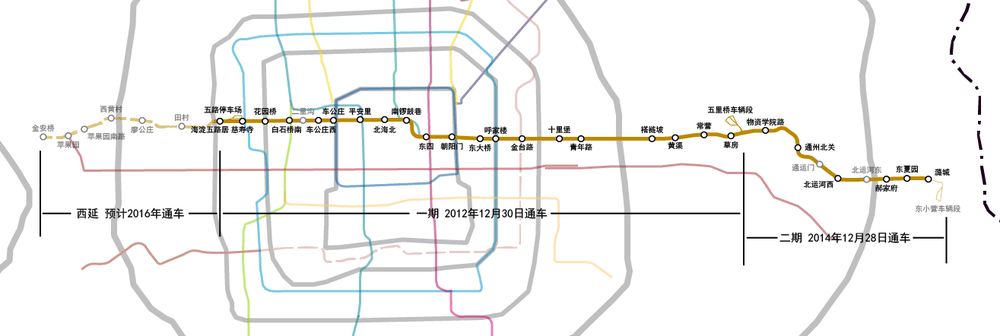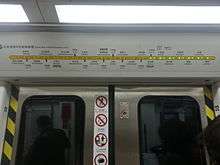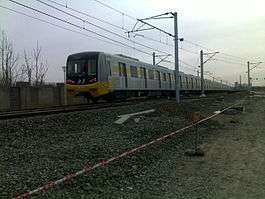Line 6, Beijing Subway
| Line 6, Beijing Subway | |||||||||||||||||||||||||||||||||||||||||||||||||||||||||||||||||||||||||||||||||||||||||||||||||||||||||||||||||||||||||||||||||||||||||||||||||||
|---|---|---|---|---|---|---|---|---|---|---|---|---|---|---|---|---|---|---|---|---|---|---|---|---|---|---|---|---|---|---|---|---|---|---|---|---|---|---|---|---|---|---|---|---|---|---|---|---|---|---|---|---|---|---|---|---|---|---|---|---|---|---|---|---|---|---|---|---|---|---|---|---|---|---|---|---|---|---|---|---|---|---|---|---|---|---|---|---|---|---|---|---|---|---|---|---|---|---|---|---|---|---|---|---|---|---|---|---|---|---|---|---|---|---|---|---|---|---|---|---|---|---|---|---|---|---|---|---|---|---|---|---|---|---|---|---|---|---|---|---|---|---|---|---|---|---|---|
|
| |||||||||||||||||||||||||||||||||||||||||||||||||||||||||||||||||||||||||||||||||||||||||||||||||||||||||||||||||||||||||||||||||||||||||||||||||||
|
An 8-car Line 6 train | |||||||||||||||||||||||||||||||||||||||||||||||||||||||||||||||||||||||||||||||||||||||||||||||||||||||||||||||||||||||||||||||||||||||||||||||||||
| Overview | |||||||||||||||||||||||||||||||||||||||||||||||||||||||||||||||||||||||||||||||||||||||||||||||||||||||||||||||||||||||||||||||||||||||||||||||||||
| Type | Rapid transit | ||||||||||||||||||||||||||||||||||||||||||||||||||||||||||||||||||||||||||||||||||||||||||||||||||||||||||||||||||||||||||||||||||||||||||||||||||
| System | Beijing Subway | ||||||||||||||||||||||||||||||||||||||||||||||||||||||||||||||||||||||||||||||||||||||||||||||||||||||||||||||||||||||||||||||||||||||||||||||||||
| Status | Completed | ||||||||||||||||||||||||||||||||||||||||||||||||||||||||||||||||||||||||||||||||||||||||||||||||||||||||||||||||||||||||||||||||||||||||||||||||||
| Termini |
Haidian Wuluju Lucheng | ||||||||||||||||||||||||||||||||||||||||||||||||||||||||||||||||||||||||||||||||||||||||||||||||||||||||||||||||||||||||||||||||||||||||||||||||||
| Stations | 27 | ||||||||||||||||||||||||||||||||||||||||||||||||||||||||||||||||||||||||||||||||||||||||||||||||||||||||||||||||||||||||||||||||||||||||||||||||||
| Daily ridership |
601,900 (2014 Avg.)[1][2] 958,000 (2016 Peak)[3] | ||||||||||||||||||||||||||||||||||||||||||||||||||||||||||||||||||||||||||||||||||||||||||||||||||||||||||||||||||||||||||||||||||||||||||||||||||
| Operation | |||||||||||||||||||||||||||||||||||||||||||||||||||||||||||||||||||||||||||||||||||||||||||||||||||||||||||||||||||||||||||||||||||||||||||||||||||
| Opened | 30 December 2012 | ||||||||||||||||||||||||||||||||||||||||||||||||||||||||||||||||||||||||||||||||||||||||||||||||||||||||||||||||||||||||||||||||||||||||||||||||||
| Operator(s) | Beijing Mass Transit Railway Operation Corp., Ltd | ||||||||||||||||||||||||||||||||||||||||||||||||||||||||||||||||||||||||||||||||||||||||||||||||||||||||||||||||||||||||||||||||||||||||||||||||||
| Character | Underground | ||||||||||||||||||||||||||||||||||||||||||||||||||||||||||||||||||||||||||||||||||||||||||||||||||||||||||||||||||||||||||||||||||||||||||||||||||
| Technical | |||||||||||||||||||||||||||||||||||||||||||||||||||||||||||||||||||||||||||||||||||||||||||||||||||||||||||||||||||||||||||||||||||||||||||||||||||
| Line length | 42.8 km (26.6 mi) | ||||||||||||||||||||||||||||||||||||||||||||||||||||||||||||||||||||||||||||||||||||||||||||||||||||||||||||||||||||||||||||||||||||||||||||||||||
| Track gauge | 1,435 mm (4 ft 8 1⁄2 in) standard gauge | ||||||||||||||||||||||||||||||||||||||||||||||||||||||||||||||||||||||||||||||||||||||||||||||||||||||||||||||||||||||||||||||||||||||||||||||||||
| Electrification | 1500 V Overhead line | ||||||||||||||||||||||||||||||||||||||||||||||||||||||||||||||||||||||||||||||||||||||||||||||||||||||||||||||||||||||||||||||||||||||||||||||||||
| Operating speed | 100 km/h | ||||||||||||||||||||||||||||||||||||||||||||||||||||||||||||||||||||||||||||||||||||||||||||||||||||||||||||||||||||||||||||||||||||||||||||||||||
| |||||||||||||||||||||||||||||||||||||||||||||||||||||||||||||||||||||||||||||||||||||||||||||||||||||||||||||||||||||||||||||||||||||||||||||||||||
Line 6 of the Beijing Subway (Chinese: 北京地铁6号线; pinyin: běijīng dìtiě liùhào xiàn) is a rapid transit rail line in central Beijing. The line currently runs parallel to the north of Line 1 and the Batong Line, from Wulu in Haidian to Lucheng in Chaoyang District. It serves important residential areas such as Changying, Chaoqing, and Dingfuzhuang,[4] in addition to important commercial and business areas such as Financial Street and Beijing CBD.[5] It is planned that the line will be extended by 2015 to Shijingshan to the west. With this extension, it is expected to be 50.67 km long with 32 stations.[6][7]
Line 6 uses Beijing Subway's highest capacity rolling stock to date featuring 8-car size B train sets accommodating 1,960 people, compared to the standard 6 cars found on other lines except the Airport Express line which has 4-car train sets.[8] It is also the fastest in the subway system, with trains capable of reaching the speed of 100 km/h compared to 80 km/h on other lines. Stations to the east of the 3rd Ring Road to Tongzhou are more widely spaced, the furthest being 4 km apart. These factors allows passengers to travel the whole line in just 48 minutes. Line 6 also has the deepest station in the network, Dongsi Station, which is 34 meters underground.[9] The line uses 1500 V overhead catenary as opposed to 750 V third rail used on other lines.[10] Some of the station arrangements where the first of its kind in Beijing. Beijing's first split platform station and stations equipped with passing tracks, opened on Line 6.[5]
Planning
Line 6 was originally planned to be an east west line passing under Chaoyang Avenue continuing straight westward. However this alignment will make the central section of Line 6 tunnel extremely close to the Forbidden City. Issues of historic conservation and protection were raised against the proposed alignment. To avoid damaging cultural relics in the area, the entire western and middle section of line 6 was shifted 1.5 km northward to Ping'an Avenue, forming the route of Line 6 today.[11][12] Line 6 started construction on December 8, 2007 as one of the "horizontal" east west lines of the "three-ring, four horizontal and five vertical and seven radial" Beijing Subway masterplan.[13]
Line 6 was originally planned to terminate at Cishousi Station with the Mentougou Low Speed Maglev Line continuing the line westward. However issues of low of capacity and electromagnetic radiation concerns of Maglev technology, the Mentougou Maglev section between Cishousi and Pingguoyuan station was replaced by a new Phase 3 western extension of Line 6.[14] Later the plan was revised with Line 6 being further extended westward beyond Pingguoyuan to Jin'anqiao station, paralleling the Mentougou Maglev Line.[15]
Route and Stations

Construction is planned in three phases, the first phase in central Beijing, followed by extensions into the eastern and western suburbs. Line 6 is projected to have a short term volume of 700,000 passengers per day and a long term daily passenger traffic of 1.4 million passengers. Though due to its alignment through some of Beijing's densest residential neighborhoods and paralleling the overcapacity and busy Line 1, some industry leaders believe that the average daily passenger flow of the line may reach 1.4 million passengers per day sooner than expected.[10] Within the first few months of operation weekday ridership was at 320,000 passengers. However, by 2014, daily ridership has risen to 700,000 with sections operating at 100% capacity during rush hour. Authorities responded by adding more trains and shortening headway to reduce crowding.[2]
Phase I

In Phase I, Line 6 runs 30 km from Wulu in Haidian District to Caoying in Tongzhou District following Linglong Road, Sanlihe Road, Chaoyang North Rd., the west bank of the Grand Canal, and Grand Canal East Road. Of the 20 planned stations, 12 will offer transfer connections to other lines. Construction began in December 2007 and was completed in 2012. Total investment for Phase I was estimated at ¥19.7 billion.[16]
Line 6 in Phase I was originally slated to have elevated tracks for 7 km, east of the 5th Ring Road, from Dingfuzhuang and Changying. After residents along the route raised concerns about train noise, planners reconsidered and ultimately decided to keep all of Phase I under ground.[17][18][19] This made the first phase of Line 6 completely underground.[20]
Phase II (eastern extension)

In Phase II, Line 6 was extended further east by about 12 km through 7 stations from Caofang to Lucheng in the Tongzhou New City. It is planned to have express and local services using passing tracks at select stations.[21]
Like Phase I, Phase II track is entirely underground.
Phase III (western extension)
In 2011, city planning authorities proposed to detach from the planned Line S1 of the Beijing Suburban Railway (Mentougou Line) and add to Line 6 as a western extension, an 8.9-km section with five stations from Pingguoyuan to Tiancun.[22][23] The revision, made in response to public concerns about electromagnetic radiation from maglev trains on Line S1 and to expand Pingguoyuan into mass transit hub, was formalized and submitted to the National Development and Reform Commission for review in March 2012.[23]
The planned stations, from west to east, are:
|
Three of the five stations will be below ground and the other two stations will be elevated above ground.[23]
Stations
Stations from west to east (and transfer stations with other lines):[16]
| |
|
|
|
|
|
|
| ● | ● | Haidian Wuluju | 海淀五路居 | 61 73 92 121 334 335 336 355 414 489 505 507 588 653 658 698 952 981 982 983 BRT4支(快速公交4支) 夜3 夜13 运通110 运通113 运通114 运通115 运通118 | Haidian | |
| ● | ● | Cishousi | 慈寿寺 | 10 | 27 33 40 61 73 85 481 489 507 588 632 夜3 | |
| ● | ● | Huayuanqiao | 花园桥 | 27 61 73 74 77 86 118 300 323 374 437 634 645 653 693 701 967 968 特6 特8 夜3 夜30 运通103 运通201 | ||
| ● | ● | Baishiqiao South | 白石桥南 | 9 | 27 61 86 92 114 118 653 693 701 717 特18 夜3 | |
| | | | | Erligou | 二里沟 | Haidian/Xicheng | ||
| ● | ● | Chegongzhuang West | 车公庄西 | 15 19 26 45 65 94 107 118 693 697 701 特4 特19 夜3 夜14 | Xicheng | |
| ● | ● | Chegongzhuang | 车公庄 | 2 | 19 21 44 80 84 107 118 332 375 387 392 606 618 632 691 693 694 701 特4 特12 夜3 夜8 夜20 夜21 运通106 | |
| ● | ● | Ping'anli | 平安里 | 4 | 3 13 22 38 42 88 105 107 111 118 332 409 701 特13 夜3 夜4 夜10 夜21 | |
| ● | ● | Beihai North | 北海北 | 3 13 42 107 111 118 612 701 观光3 夜3 夜10 夜21 | ||
| ● | ● | Nanluoguxiang | 南锣鼓巷 | 8 | 3 13 42 60 82 115 118 612 701 夜3 夜21 | Dongcheng |
| ● | ● | Dongsi | 东四 | 5 | 58 101 106 109 110 112 116 128 140 684 夜10 夜13 | |
| ● | ● | Chaoyangmen | 朝阳门 | 2 | 44 58 75 101 109 110 112 140 650 BRT2(快速公交2) 特2 特12 夜13 夜20 | Dongcheng/Chaoyang |
| ● | ● | Dongdaqiao | 东大桥 | 28 43 75 98 101 109 110 112 118 120 126 140 350 403 433 515 615 650 673 BRT2(快速公交2) 夜6 夜13 夜24 | Chaoyang | |
| ● | ● | Hujialou | 呼家楼 | 10 | 75 113 126 140 350 402 405 417 421 650 671 673 BRT2(快速公交2) 特8 夜6 夜30 夜34 运通107 | |
| ● | ● | Jintailu | 金台路 | 14 | 9 30 31 75 117 126 140 306 419 486 502 619 621 635 640 682 973 976 985 988 夜6 夜25 | |
| ● | ● | Shilipu | 十里堡 | 75 126 140 306 486 595 640 675 682 911 991 夜3 夜6 | ||
| ● | ● | Qingnianlu | 青年路 | 75 126 306 412 419 450 468 494 499 553 581 605 675 682 911 991 夜3 夜6 夜13 运通111 运通121 | ||
| ● | ● | Dalianpo | 褡裢坡 | 306 499 517 675 911 | ||
| ● | | | Huangqu | 黄渠 | 306 499 517 583 587 675 911 | ||
| ● | ● | Changying | 常营 | 306 342 585 586 587 639 675 911 | ||
| ● | | | Caofang | 草房 | 306 342 517 582 585 586 587 639 675 813 819 824 911 专115 | ||
| ● | | | Wuzixueyuanlu | 物资学院路 | 342 582 587 675 813 824 911 | Tongzhou | |
| ● | ● | Tongzhou Beiguan | 通州北关 | 316 342 587 648 911 924 | ||
| | | | | Tongyunmen | 通运门 | |||
| ● | | | Beiyunhe West | 北运河西 | 317 552 809 | ||
| | | | | Beiyunhe East | 北运河东 | |||
| ● | | | Haojiafu | 郝家府 | |||
| ● | ● | Dongxiayuan | 东夏园 | 804 | ||
| ● | ● | Lucheng | 潞城 | |||
History
- As of October 2007, Line 6 was planned to feature both express and local stations, but those plans have not been incorporated into the construction of Phase I.[24]
- On March 22, 2010, the tunneling work on Line 6 commenced near Shilipu in Chaoyang District.[25]
- As of November 2010, plans for Phase II contained distinct express and local stations.[26]
- On December 28, 2014, the Phase II stations opened, except Tongyunmen and Beiyunhe West.
References
- ↑ "客流信息". Beijing Subway. Retrieved 2015-03-20.
- 1 2 "晚高峰加小圈车 地铁6号线满载率降12%". 首都之窗. 2014-08-22. Retrieved 2014-09-14.
- ↑ "北京地铁日客流创纪录 首破1200万大关". 搜狐. 2016-03-27. Retrieved 2016-03-26.
- ↑ "6号线助力朝北新盘崛起". 2012-11-30. Retrieved 2012-12-29.
- 1 2 "轨道交通6号线预计年底试运营 五项第一彰显北京地铁新奇迹". 北京市交通委员会. 2012-09-26. Retrieved 2012-09-26.
- ↑ "北京地铁6号线西延通过专家评审 全长52公里共33站". 2012-11-14. Retrieved 2012-12-29.
- ↑ 温薷 王嘉宁 (2013-03-15). "地铁六号线二期拟增至8站点". Retrieved 2013-03-16.
- ↑ (Chinese) "4条地铁线将装屏蔽门" 法制晚报 January 20, 2010
- ↑ <New Beijing subway to ease traffic congestion, Wu Wenjie, deputy director of China Railway Tunnel Group, China Daily. Reporter ZHENG Xin. 2012-11-26.
- 1 2 (Chinese) "四条地铁新线12月28日同步开通(图)" 2012-08-31
- ↑ 中国中央电视台. 《超级工程》第三集《北京地铁网络》. Event occurs at 07:20. Retrieved 2012-12-29.
- ↑ "2012年九月份科普论坛报告会". Retrieved 2012-12-29.
- ↑ "北京5条新地铁12月8日同时开工建设". 2007-12-08. Retrieved 2012-12-29.
- ↑ "8号线3期6号线西延将开工 2015年总里程666公里". 2011-04-27. Retrieved 2012-12-29.
- ↑ "北京地铁6号线西延工程变更公示". 中国铁道科学研究院. 2013-11-21. Retrieved 2013-11-21.
- 1 2 (Chinese) Beijing Infrastructure Investment Co., Ltd. Line 6 Plan, BII Accessed on September 6, 2008
- ↑ 北京地铁6号线可能噪音扰民 有望改走地下 ->(行业动态)->行业动态->筑龙网
- ↑ 北京市规划委员会关于北京地铁6号线高架线的复函 - 房产 - 青传媒
- ↑ "北京市规划委回复人民热线:地铁6号线一期工程均为地下线" 人民网 October 13, 2008
- ↑ "轨道交通6号线一期工程规划方案公告". 北京市规划委员会. 2010-01-14. Retrieved 2012-12-29.
- ↑ http://society.people.com.cn/n/2013/1113/c1008-23531866.html
- ↑ (Chinese)北京地铁6号线西延段放弃采用磁悬浮形式 July 2, 2011
- 1 2 3 (Chinese)"地铁6号线将西延至杨庄东街" 2012-03-23
- ↑ 北京地铁6号线方案获批复 将尝试大站快车(图)_TOM新闻
- ↑ (Chinese) 6号线一期开始“挖地道” March 23, 2010
- ↑ (Chinese) 2010-11-18
External links
-
 Media related to Line 6, Beijing Subway at Wikimedia Commons
Media related to Line 6, Beijing Subway at Wikimedia Commons
